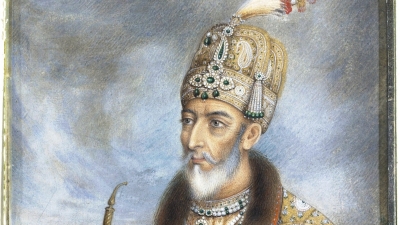
The last Mughal emperor, Bahadur Shah II, also known as Zafar, died in a British prison in Burma in 1862. As the last of the dynastic line that extended back to the sixteenth century, he had in his earlier years presided over a culturally sophisticated court, but as the British East India Company extended its control over more of India, his rule was clearly coming to an end. Then the mutiny of the sepoys against their British officers led to the siege of Delhi, the establishment of direct British colonial rule, and the end of any pretensions of Zafar as emperor. Dalrymple has mined the Persian and Urdu archives to capture the culture of Zafar’s court life — a culture of artists and intellectuals, of Muslims and non-Muslims alike. Dalrymple has little to say about what triggered the mutiny, but he does add greatly to the standard picture of the horrors of the fighting that destroyed a great deal of the city of Delhi.
Zafar’s father, Akbar II, had been imprisoned by the British and he was not his father’s preferred choice as his successor. One of Akbar Shah’s queens, Mumtaz Begum, pressured him to declare her son, Mirza Jahangir, as his successor. However, The East India Company exiled Jahangir after he attacked their resident, in the Red Fort, paving the way for Zafar to assume the throne.
Bahadur Shah Zafar was a noted Urdu poet, having written a number of Urdu ghazals. While some part of his opus was lost or destroyed during the Indian Rebellion of 1857, a large collection did survive, and was compiled into the Kulliyyat-i-Zafar. The court that he maintained was home to several prolific Urdu writers, including Mirza Ghalib, Dagh, Mumin, and Zauq.
Picture Credit : Google

